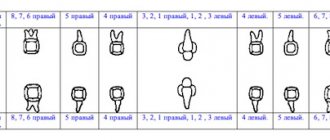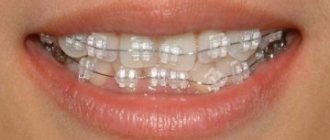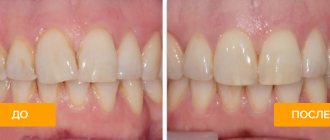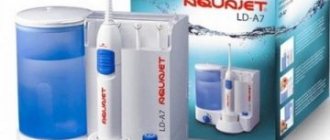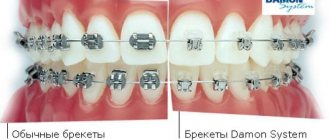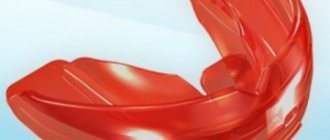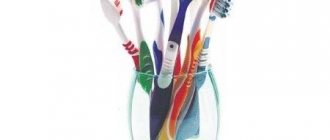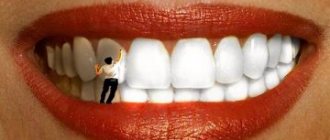One of the main ways to correct bites in adults today is vestibular, or external braces. And in everyday life we simply call them in one word - “braces”. They are fixed on the outer surface of the teeth and all the surrounding structures on the teeth are visible when the patient smiles. Something like this (see photo)
You can discuss the pros and cons for as long as you like, since they have their own advantages and disadvantages, like any bite correction system. But there are several main points. And you need to know them.
There are four advantages of external braces when correcting malocclusion:
- Firstly
, today vestibular braces are the most functional device that orthodontists can use in adults. - Second plus
. Treatment with braces really gives a fairly quick visual effect. - Thirdly
, external braces provide probably the greatest expansion. - The fourth plus
is that in terms of cost, they are probably one of the most affordable options for correcting a bite, which is important for adults.
The disadvantages are that, no matter what kind of braces orthodontists choose - metal or so-called aesthetic (transparent), ceramic, sapphire - when correcting a bite, the disadvantages are the following.
Disadvantages of external braces when correcting bites in adults:
- Firstly
, any external braces are still visible, and this very often influences the choice by adults of one or another method of treating malocclusion.
- Second minus
. In addition, of course, they contribute to the accumulation of plaque, which means hygiene is significantly reduced. And the accumulation of plaque leads to tooth decay. Therefore, you have to carefully clean your teeth and braces using special brushes. This is really tiring and it is never possible to completely clear the plaque (if you also violate your diet - see the fourth minus)
- The third disadvantage
: braces really rub the mucous membrane, especially at first they can strongly rub the mucous membrane of the cheeks and lips.
- Fourthly
, external braces also impose restrictions on the intake of hard foods, be it meat, apples, and so on.
- Fifth minus
. From the point of view of psychological comfort, vestibular braces are also, of course, constraining.
Pros and cons of braces according to doctors' reviews
Real reviews from doctors about the pros and cons of braces boil down to the fact that the main advantage of these devices is their ability to correct even the most complex malocclusions, unlike other orthodontic devices, and the disadvantage is the difficulty of care and aesthetic qualities (with the exception of certain types of braces) . In addition, experts do not advise choosing braces based on numerous tables on the Internet, which compare treatment periods for different types of braces and prices for these designs. Why?
Firstly, every patient must understand that the degree of impact on the teeth and the duration of the correction process are the same for all braces. This is due to the natural mechanism of tooth movement. Secondly, the following can be said about the cost of braces. There are clinics that offer expensive sapphire braces for the price of ceramic ones. And it's not a joke. It’s just that the cost of orthodontic structures and services for their use depends on the pricing policy of dentistry, and not on the quality of braces or the qualifications of the doctor. Therefore, in our article we will, of course, talk about approximate prices for this or that type of braces, but, basically, we will evaluate bracket systems according to the following criteria:
- aesthetics;
- reliability;
- comfort of wearing;
- ease of care.
Interesting fact!
According to rumors, scientists at Oxford University are working on creating magnetic braces. They say that the principle of their operation will be based on the creation of a constant magnetic field using two miniature generators, which will act on the iron contained in the teeth and effectively correct the bite without the need to wear any structures.
Advantages of aligners over braces
The two main advantages - aesthetics and wearing comfort - are due to the design of this product. This allows you not to experience embarrassment during treatment, as happens when wearing braces, when a person is embarrassed to smile and talk, experiencing stress and becoming withdrawn, refusing to communicate. Aligners eliminate such problems - they make you look the same as usual, and in extreme cases they can be removed altogether.
Aligners are more effective than braces in another respect: there are almost no restrictions on food intake. Even solid foods can be eaten if they are removed before meals. It is impossible to remove the braces for a while, so you will have to eat in them, which means you will have to give up solid food, which can break the structure, and after eating, rinse your mouth thoroughly and brush your teeth using special brushes and toothpicks, since food gets stuck between them much more strongly. teeth.
Well, difficulties in oral hygiene will result in the development of caries if the patient allows himself to relax and not be too diligent in caring for the oral cavity. When using aligners, such problems do not arise, you can eat and brush your teeth as usual.
Finally, what makes you choose aligners instead of braces is their purely medical effectiveness - treatment with aligners is faster, and you can change the aligners yourself if necessary. Aligners cover the teeth more tightly and transfer the load to them more evenly, allowing them to be moved in several axes at once, which speeds up treatment and at the same time makes it safer and more comfortable.
Type of braces
Ligature braces
- the elasticity of the ligatures ensures more comfortable wearing of braces.
- affordable price.
- It is necessary to change the ligatures regularly (about once a month), as they stretch while wearing braces.
- a more complex hygiene procedure due to the presence of ligatures.
Braces without ligatures
- There is no need to replace ligatures, so you can visit the doctor less often.
- Easier oral care routine.
- are more expensive than ligature braces.
Do your teeth hurt during treatment?
After braces are installed, the cost of which in Moscow can vary significantly depending on the clinic, a person may begin to experience discomfort. What is this connected with? This reaction is quite normal. People may experience discomfort for up to seven days. To ease the “suffering”, you can take an anti-inflammatory drug. It should be prescribed by a doctor - under no circumstances should you self-medicate.
Unpleasant sensations are normal. The gums need to get used to braces - a foreign object. To alleviate the condition, you can use a saline solution. How to cook it? Dissolve a couple of teaspoons of salt in a glass of water and rinse your mouth with the solution at least twice a day.
If your teeth become more sensitive after getting braces, avoid eating hard foods. Eat soft foods: mashed potatoes, yogurts, soups, etc. If the pain worsens, you can eat something cold.
Ceramic braces - pros and cons
These orthodontic systems are made from dental ceramics. Having analyzed the pros and cons of non-ligature and ligature ceramic braces, we can conclude that such brace systems represent good value for money, allowing you to solve any bite problems at an affordable price, which in Moscow clinics is about 30,000 rubles for the design itself. one row of teeth. In this case, diagnostics, installation and removal of the system will have to be paid additionally.
Methods for fixing dental locks
In this regard, a distinction is made between ligature and non-ligature (self-ligating) bracket systems. In the first case, the design includes additional elements - ligatures, which require a regular monthly visit to the dentist to tighten them. In turn, self-ligating braces allow the patient to visit the dentist much less frequently. In addition, the locks in such gentle systems are much smaller and, accordingly, less noticeable on the teeth.
In some cases, mainly to correct malocclusion in children, all kinds of removable structures are used - for example, mouthguards or aligners. However, in case of serious disorders (especially in adults), such devices will be ineffective.
Sapphire braces - pros and cons
These are transparent braces made from artificial sapphire, which really do not spoil the patient’s appearance, but look like a stylish accessory. As for the pros and cons of sapphire braces, their main advantage is considered to be high aesthetics, and a significant disadvantage is the price, since most often they cost much more than ceramic ones. However, there are cheaper options for sapphire designs combined with metal or ceramic. Thus, the cost of braces made entirely of sapphire starts in Moscow clinics from 70,000 rubles per design for one row of teeth.
What is a retainer?
A retainer is a small arch that is placed on the inside of the teeth after braces are removed. That is, it consolidates the result of treatment of malocclusion. Retainer placement is required for all patients over 25 years of age. You have to wear it for a long time - twice as long as wearing braces. It is believed that the optimal period is four years. After this time, the person must wear a mouthguard at night.
And all these procedures must be performed without fail, otherwise the result of the treatment will not be consolidated. A person must realize that changes in the functioning of the body must be completed. Otherwise, correcting the bite with braces will be done in vain.
Type of braces
Lingual
- completely invisible.
- as durable as metal systems.
- are more expensive than ceramic braces.
- They are more difficult to maintain than labial systems, which are attached to the outside of the teeth.
- significantly affect diction.
Of course, the above pros and cons of braces will play an important role in shaping your preferences regarding one or another type of these orthodontic structures. However, we will tell you a secret: the best braces for each patient will be those that will help him solve his particular bite problems. Therefore, an experienced and knowledgeable orthodontist will help you choose the right bracket system after examining and diagnosing your teeth.
Metal constructions
Metal braces are considered a classic option for correcting malocclusion and are still in demand in modern dentistry. The main advantages of such designs:
- Efficiency. Correcting a bite with metal braces has been time-tested and the techniques have been developed over many decades. Bite correction with such braces is well predictable and controllable.
- Strength. Metal braces, due to their high strength, do not require too delicate and careful handling, and are resistant to chewing loads.
- Easy to care for. Any type of braces must be carefully and regularly maintained. However, cleaning teeth with metal braces is somewhat easier than with structures made of other materials.
- Affordable price. One of the most important advantages of metal braces is that they are considered one of the most affordable options for correcting malocclusion. With metal braces, you can achieve good results without shelling out a fortune for treatment.
- Possibility to choose a hypoallergenic alloy. Metal braces can be made from alloys of different metals, so everyone can choose braces that will not provoke an allergic reaction.
The disadvantages of metal braces include:
- Low aesthetics. Most patients find metal braces on their teeth extremely unaesthetic and undesirable. Vestibular metal braces are clearly visible during smiling, talking and eating, so you should immediately tune in to this if you want to correct your bite at an affordable price.
- Possible discomfort while wearing. Metal structures are quite massive and can have an irritating effect on the oral mucosa. However, it is important to understand that at first any brace system can cause discomfort until you get used to the foreign object on your teeth.
The insufficient aesthetics of metal braces can be eliminated if you choose a lingual type of braces. These braces are attached to the lingual surface of the tooth and are not visible from the outside. The only disadvantage of this design is the possible appearance of minor diction disorders, since lingual braces are more massive. Also, metal lingual braces are much more expensive than regular metal braces.
According to the fixation method, the patient can choose ligature and non-ligature metal braces. A dentist who understands all the intricacies and nuances of installing braces will tell you which option is more effective in your clinical situation.
FAQ
How does the oval of the face change after braces?
The face after braces becomes more symmetrical and proportional. This is a consequence of correcting the bite. For example, if a patient’s teeth do not close together and the face appears elongated, then after correction with braces the cosmetic defect is eliminated. Most often, after such treatment, the cheekbones become more expressive and the cheeks become sunken.
Is it possible not to wear retainers after braces?
Can. However, the consequences of such a decision are difficult to predict. The teeth will again try to return to their previous position. And then, 1-2 years of correction with braces will be useless.
Do braces make your lips look bigger?
Visually, yes, because there is a bracket arch under the lip. However, after removing the structure, the effect of lip augmentation disappears.
Do teeth fall out from braces?
No, they don't fall out. And information about this is just rumors that have no basis.
Adaptation period
Getting used to the orthodontic appliance takes about 2 weeks. Patients adapt to aligners more easily and quickly than to braces. This is due to the fact that mouthguards for straightening teeth can be removed independently, the elastic material does not injure the soft tissue, and due to the precise fit of the structure, sound pronunciation is not disturbed.
It is more difficult to get used to braces due to their design features. In addition, the first days of treatment are accompanied by pain. But in any case, adaptation to the corrective apparatus does not take more than 10-14 days.
